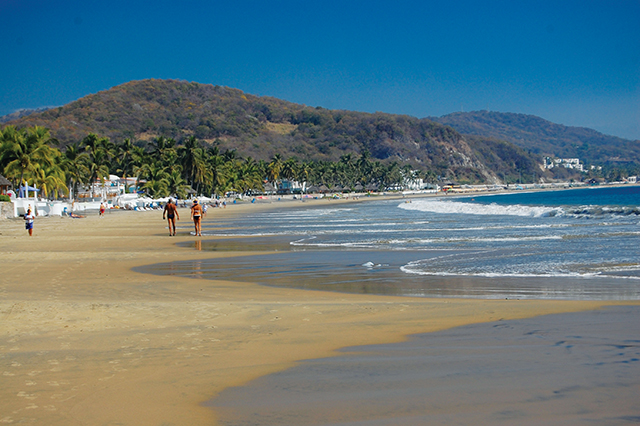Cruising the “Gold Coast” (published April 2012)
The Pacific coast of Mexico stretches for hundreds of miles, but the prime cruising ground is a short 50-mile stretch south of Puerto Vallarta. Fondly called the “Gold Coast” by cruisers for decades, it is also known as the “Costa Alegre” or “Costalegre,” which translates as the “Happy Coast.” The exact boundaries vary depending on whom you ask, but my husband Mark and I found that the best of the best lies between Chamela Bay at the north end and Manzanillo at the south end.
We took the express route down the coast on our Hunter 44DS, Groovy. On our return trip north we took our time, however, and discovered the charms of these anchorages in the reverse order from most cruising itineraries.
MANZANILLO & SANTIAGO
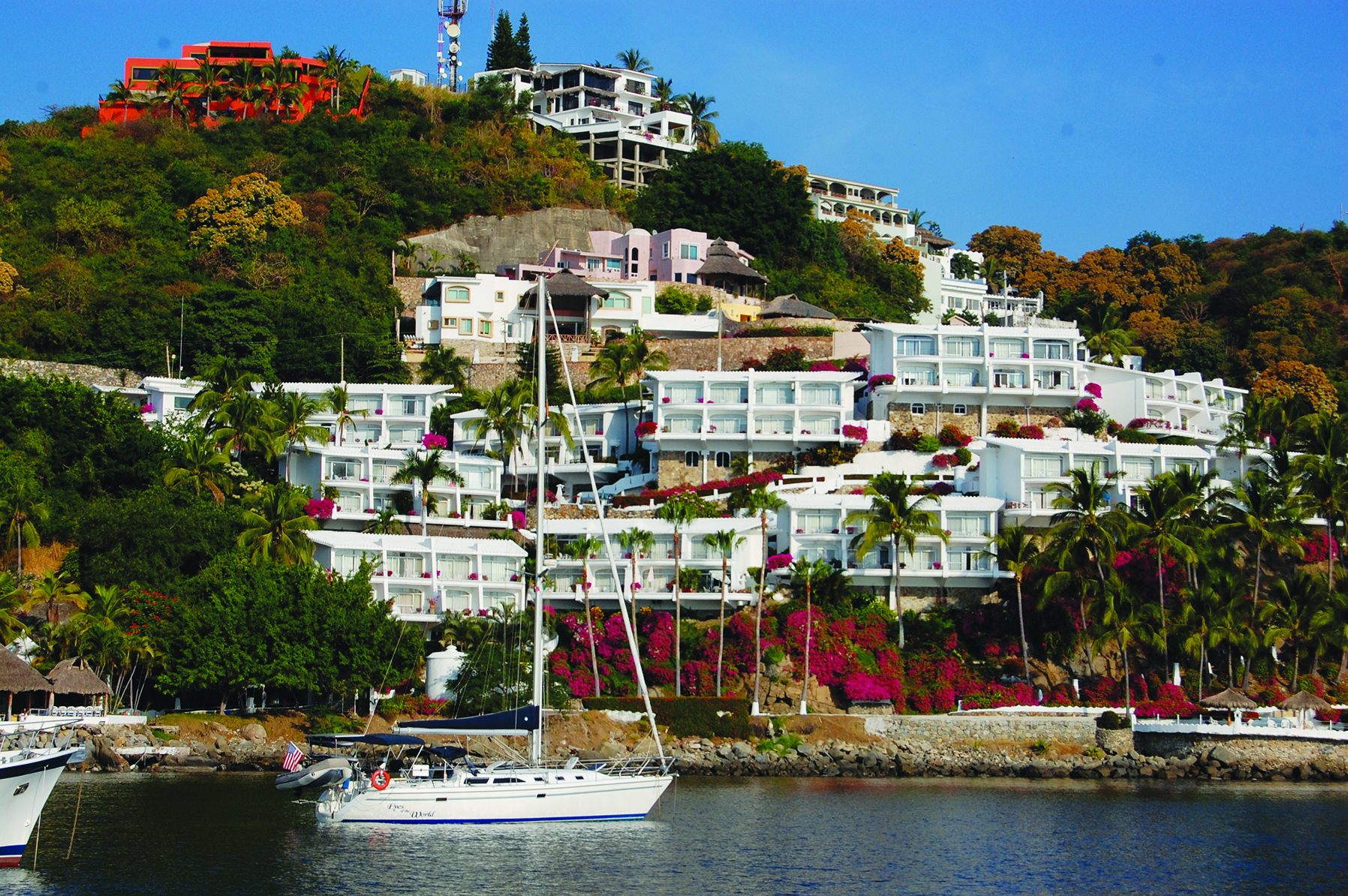 When we arrived at Las Hadas Resort in Manzanillo (www.brisashotelonline.com/manzanillo), our eyes nearly popped out of our heads. The hillsides encircling the small cove were covered with a whitewashed cascade of fairytale villas and turrets, all trimmed with vivid magenta bougainvillea. Awed by the views, we felt like we were in the Mediterranean. We dashed ashore in the dinghy and quickly got lost on the up-and-down cobblestone paths that are layered onto the hills.
When we arrived at Las Hadas Resort in Manzanillo (www.brisashotelonline.com/manzanillo), our eyes nearly popped out of our heads. The hillsides encircling the small cove were covered with a whitewashed cascade of fairytale villas and turrets, all trimmed with vivid magenta bougainvillea. Awed by the views, we felt like we were in the Mediterranean. We dashed ashore in the dinghy and quickly got lost on the up-and-down cobblestone paths that are layered onto the hills.
Manzanillo is a photographer’s paradise, and we happily spent hours roaming around, taking pictures of crazy gargoyles climbing the turrets, generous balconies hanging over the anchorage, and fanciful moorish arches and curving staircases leading to stunning overlooks and exclusive hideaways.
Las Hadas (“The Fairies”) Resort was built by Bolivian tin baron Don Antenor Patiño as a personal getaway. Opened to the public in 1974, the resort became the setting for the movie 10 a few years later, which put this small gem on the map. Wandering around, we found a two-room museum dedicated to the resort’s history, complete with an old local newspaper article about Bo Derek, for which she posed nude. That night we rummaged through our DVD collection to watch 10 one more time. How cool to see Dudley Moore and Bo Derek cavorting in some of the places we’d just been that day.
Four hundred years ago, Spanish explorers thought they saw fairies in the waters of Manzanillo Bay by the light of the harvest full moon. No one knows exactly what they saw, but suspicions are that it was twinkling bioluminescence. An oar stirring the water at night generates a shimmering burst of sparkles, and as Groovy rocked gently in the swell, it seemed like she was casting stars into the black depths around her. We couldn’t keep ourselves from doing donuts in the dinghy just to see our pale blue trail light up.
Other resorts and private villas embrace this bay too, and we followed a pretty walking path along the waterfront that weaved in and out of palm trees. Elegant restaurants provide harbor-front views, and one offers cruisers discounts and free Wi-Fi. Las Hadas Resort allows cruisers to use their amenities for 100 pesos per day (about $9). Swimming in the pretty royal blue pool under the palms is well worth the fee, and many cruisers spend a week or more hanging out poolside.
We had been cruising for a while when we got to Las Hadas and needed provisions. Fortunately, a scenic walk through the neighboring Barceló Resort’s (www.barcelo.com) golf course took us to a collection of big box stores and supermarkets. We were low on fuel, too, and we faced the tricky dilemma of how to get it aboard. There is a short fuel dock at Las Hadas marina, and most cruising boats have to stern tie to the dock and throw an anchor off the bow for fueling. We weren’t keen on tight maneuvering, especially after we saw the boulders that lie just below the surface around the fuel dock, so we dinghied over with jerry jugs a few times.
One day, we caught the city bus in front of Las Hadas. The ride was breathtaking, if a bit scary, as it bumped along at a very fast clip over the steep, winding cobblestoned streets to the main road. The views were inspiring, even through crummy bus windows. Downtown Manzanillo is 30 minutes away on this bus, but it is a big commercial port city that pales in comparison to the charm and sophistication of Las Hadas.
Among my favorite things about Manzanillo Bay is that it is ideal for daysailing. The wind is often spirited, and there are rarely any boats on the water. We tacked back and forth in the wide bay, and one afternoon, rather than returning to Las Hadas, we pulled into the expansive anchorage at Playa La Boquita in front of neighboring Santiago. After the intimate cove at Las Hadas, this vast anchorage felt refreshingly open, and the broad sweeping beach begged to be walked.
Long waves stroked the shore as we strolled along a line of elegant villas, all part of the gated community of Club Santiago (www.manzanilloholiday.com/club_santiago.htm). It seemed like the ideal winter vacation spot. At the far north end of the beach a public access area was filled with palapa-covered restaurants. We had heard something that sounded like a tuba while we were on the boat, and sure enough we found our tuba man playing for tables up and down the beach.
BARRA DE NAVIDAD
From Santiago, it was a quick 25-mile sail north on a perfect beam reach to Barra de Navidad. We easily crossed over the sandbar at the entrance to this estuary, but my knuckles went white on the wheel as we followed our waypoints along the narrow, steep-sided channel into the anchorage. Up until this point in our cruise there had always been just 10 or 15 boats in each anchorage. Barra, however, was packed. Well over 50 boats swung at anchor, and we soon figured out why: it is a fantastic destination.
The gleaming, swanky Grand Bay Resort (www.wyndham.com/hotels/ZLOGB/main.wnt) rises out of the hills on one side, while a funky town of retired ex-pats lies low on the other. Boatloads of cruisers in water taxis zip all over the estuary en route to dozens of colorful waterfront bistros for happy hour. Lush mangroves line the far end of the estuary, and while the sun is setting, exotic birds fly overhead on their way to roost, filling the air with their wild, tropical cries.
The next morning, the VHF radio sprang to life with cruisers checking in from all the neighboring Gold Coast anchorages on the morning cruisers’ net. No sooner was the net over than the resident French Baker showed up in his bimini-shaded panga (an open outboard-driven skiff) to sell croissants and pastries boat by boat. Emeric Fiegen, a Frenchman who emigrated to Canada, has found the perfect winter business in this estuary selling baked delicacies both from his boat (the fun way to buy them) and from a shop in town (for those who sleep too late).
We hopped on a water taxi to town and discovered the winding streets were bursting with activity. There is a coffee shop or casual outdoor eatery on every corner, and one restaurant’s balcony was even perched among the branches of a huge tree like a tree house. We stopped in at the cruiser-friendly Hotel Sands (www.hotelsandsbarradenavidad.com) and joined the other grubby boaters for a swim in the pool. There was just a short line for the outdoor shower, but a large crowd was quaffing cheap beers at the bar.
Another day we took the water taxi to the posh Grand Bay Resort, and for the (high) price of a poolside lunch, we were able to enjoy an afternoon of true tropical vacationing, including umbrella drinks, suntan oil, lounge chairs and all. Mexico has been hard hit by the negative press north of the border, and the Grand Bay was reportedly much quieter than normal. The front desk told us the room rack rate was $450 a night, but all the tourists we talked to had gotten online deals for about $100 a night.
The Barra de Navidad estuary is unique among Mexico’s Pacific coast anchorages because of its sanctuary-like stillness. Most bays are swept by the ocean’s relentless swell, and rolling and tossing are a big part of the cruising life on these waters. But Barra de Navidad is fully enclosed, and there isn’t a wave to be seen. Long nights of deep sleep are part of the package. However, the depths are shallow, the tide is minimal, and the holding is soft mud, so while we anchored in just nine feet of water, we were told by neighboring boats to put out 100 feet of chain. This turned out to be very wise. One morning the wind reversed direction and howled for hours, setting several boats adrift. Fortunately, helpful cruisers wrestled the boats into submission for the absent owners. After that we always left the key in Groovy’s ignition whenever we went ashore, just in case.
TENACATITA
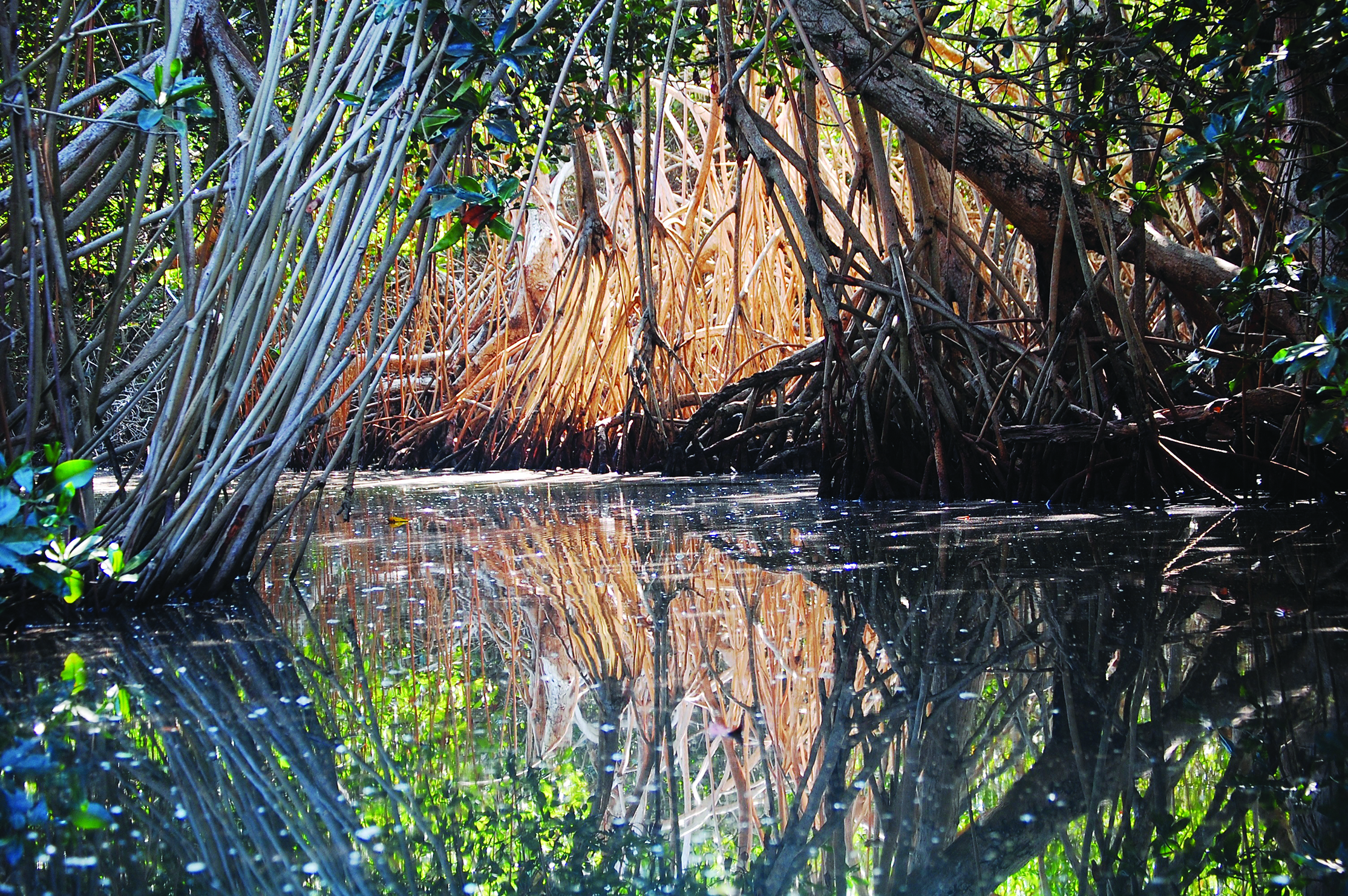
Thick-mangroves-line-the-dinghy-jungle-tour-at-Tenacatita
It is nearly impossible to leave Barra de Navidad, and we met many cruisers who stayed a month or more. But our holding tanks were full and our water tanks were empty, so necessity drove us back over the bar to the open ocean. Around the corner from Barra lies the so-called “Secret Anchorage,” or Bahía de Cuastecomates, named for a local species of tree. This tiny cove was largely unknown to cruisers until the cat was let out of the bag by the recent publication of the beautiful new book, Pacific Mexico: A Cruiser’s Guide by Shawn Breeding and Heather Bansmer. The anchorage is now very popular, but our stay was marred by a brutal swell that kept us from exploring the snorkeling reef and beach. Fortunately, the next day the winds were ideal and we had an easy sail around the point to Tenacatita.
I grew up in New England hearing about red tide and consequent beach closures, but had never seen it. Entering Tenacatita’s enormous bay, we found ourselves engulfed in a three-mile swath of burgundy water. Fortunately, the skinny, winding freshwater estuary in the bay’s north corner was out of reach of this maroon menace, and we took our dinghy on a self-guided “jungle tour” into the mangroves. Exotic long legged birds peered at us from behind the thick greenery, and soon the river narrowed to barely a dinghy’s width. We had to pull ourselves along under the low lying branches, and we spotted two ring-tailed coatimundi watching us from deep in the brush.
Eventually the river widened again into a small lake, and at the far end we could see some buildings that used to be part of an active community that had, at one time, provided cruisers with a colorful shoreside hangout. Six months before our visit, following decades of legal wrangling, a developer had evicted the entire village of about 800 squatters who had lived there for some 40 years. We had been warned not to annoy the soldiers who now guard the property, so we headed back to the bay.
The small, mostly ex-pat town of La Manzanilla lies on the south side of Tenacaitita Bay, and one morning a group of cruisers eagerly chased each other for three miles in their dinghies to get provisions there. The sudden splashing of enormous fins stopped us in our tracks. A parent and baby whale appeared to be nursing or playing. Virtually tip-toeing by, we made it to town, where we found lots of stores, some even owned by gringos. But we had to shop quickly because the surf on the beach builds all day. We got it all done and launched the dinks through the surf just in the nick of time for a wet and bumpy ride back to the boats.
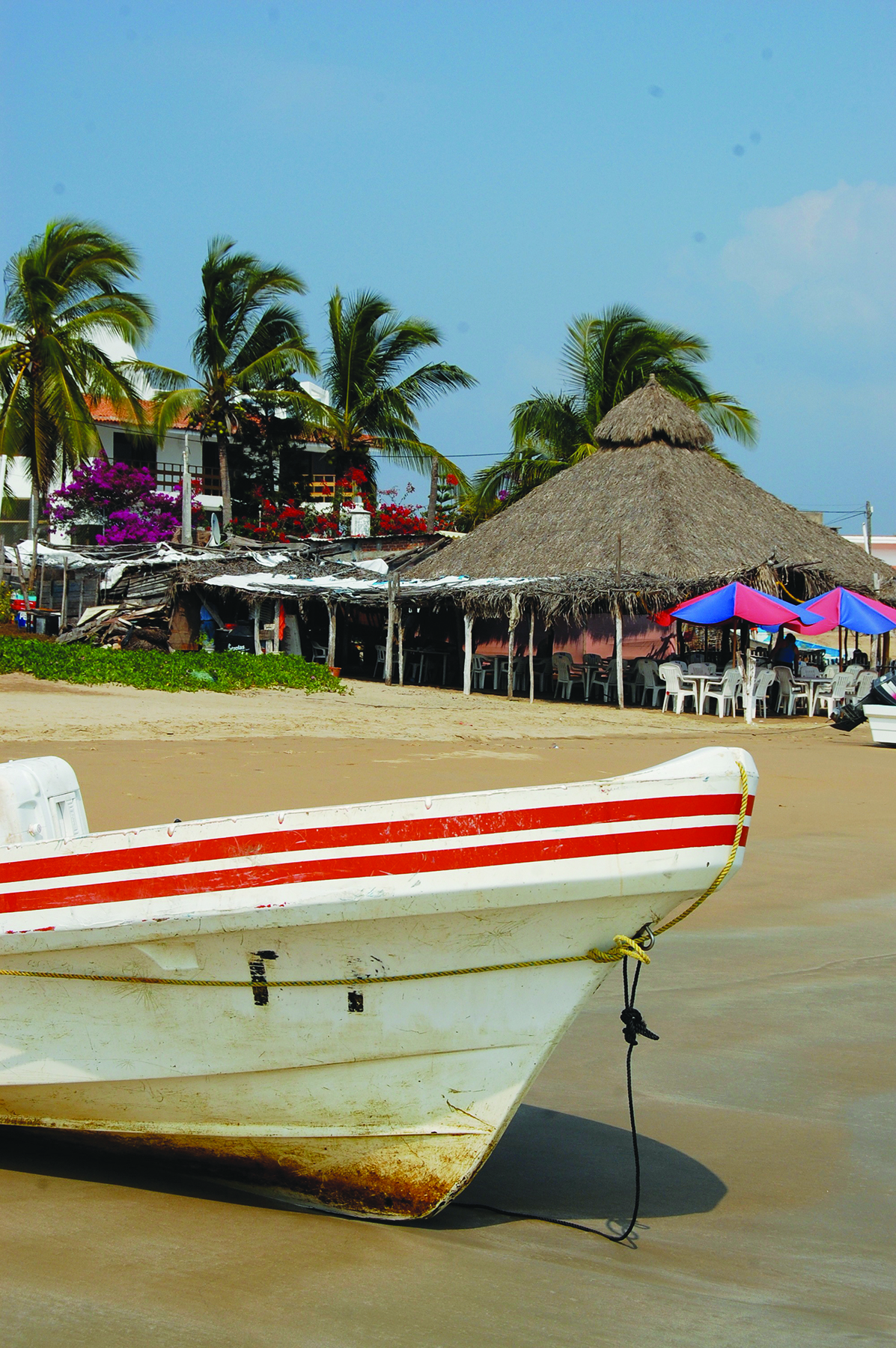
A-panga-on-the-beach-at-Chamela-Bay
CHAMELA BAY
We had just begun to think about moseying north another 25 miles when the Japanese tsunami warning sent the entire cruising fleet in Mexico out to sea for a day. This was the perfect opportunity to make our way north to Chamela Bay, where we took a spot between a cluster of small islands that lie slightly offshore. Instantly, the calls of mating pelicans lured us onto a tiny beach in the dinghy. Walking towards the trees we could see hundreds of pelicans standing on the branches, courting, wooing and making the most exotic (and erotic) sounds. It seemed like we had walked into a very public pelican orgy. Leaving the birds to themselves, we wandered over to a series of tidepools that were teeming with periwinkles and tiny crabs, all hanging on for dear life as the waves washed in and out. After all the human-oriented action of the more southern anchorages, this place felt remote, rugged and alive with nature.
Chamela is the end of the line for a northbound cruise through the Costa Alegre, save for a marginal anchorage 50 miles further north at Ipala. Most cruisers were continuing north around Cabo Corrientes towards Puerto Vallarta, and we joined the growing throng of boats off the main beach waiting for a weather window. SSBs, laptops and VHF radios hummed for several days while everyone tried to find the best moment to make a run for it around the notorious cape. The hour finally came, and we left on a rollicking close reach that had us alternately looking ahead to whoop excitedly and glancing wistfully astern to murmur a grateful goodbye to this wonderful, vibrant coast.
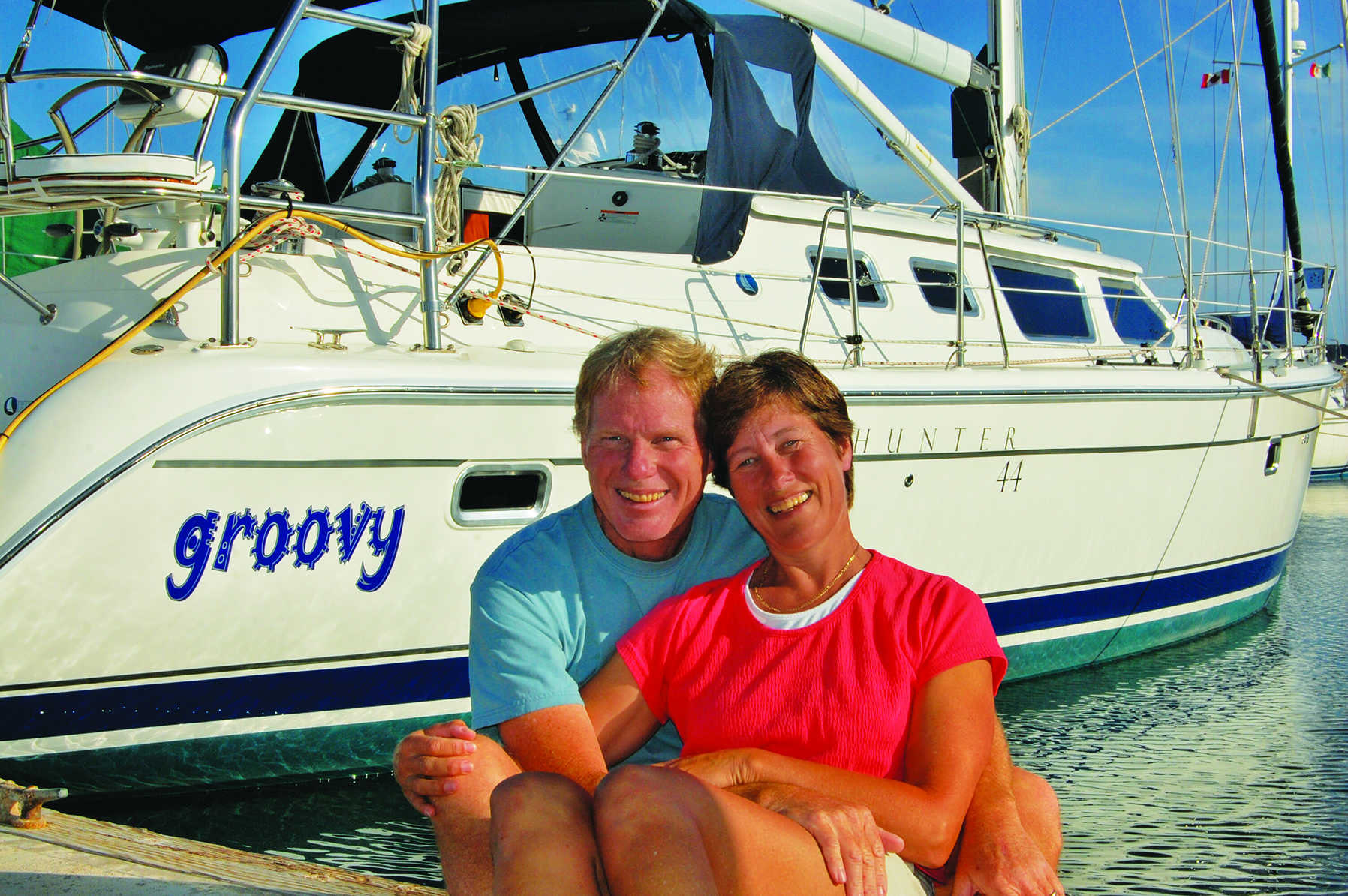 Emily and Mark Fagan have been traveling full-time for four years. They chronicle their adventures at www.roadslesstraveled.us
Emily and Mark Fagan have been traveling full-time for four years. They chronicle their adventures at www.roadslesstraveled.us















